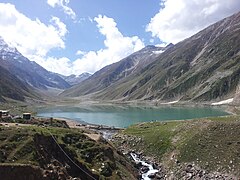Lake Saif-ul-Malook
is a famous tourist resort, well known for the associated story of a Persian prince Saif-ul-Malook. It is located about 8 kilometers (5 miles) north from the town of Naran in northern end of Kaghan Valley, in District Mansehra, Khyber Pakhtunkhwa.
The lake with its majestic and mesmerizing natural beauty, pleasant atmosphere and associated tale and history, attracts thousands of tourists each year from all around the country during the summer.
The lake is also famous for being habitat of large size Brown Trout fish, which weigh up to 7 kilograms. Lake Saif-ul-Malook also provides a marvelous view of Malika Parbat, which is the highest peak of Kaghan Valley.
Altitude:
Lake Saif ul Malook is one of the highest alpine lakes of Pakistan. It is located at an altitude of 3,224 meters (10, 578 feet) above sea level.

Depth:
There are lots of controversies about the depth of Lake Saif ul Malook. In fact, there is no authentic source to tell the exact depth of lake. The local people of the valley say Lake Saif ul Malook is 1 kilometer deep, some of them says it is 1.7 kilometers. However, a team which recently conducted a survey on all alpine lakes of Northern Areas of Pakistan told that the depth of Lake Saif ul Malook is 50 feet.
If we take a look at figures given above, the one (50 feet) provided by the team which conducted survey seems to be more realistic, as if we consider the geography of the area surrounding the lake, it would be marvel of nature for a lake to be 1-1.7 kilometers deep at an altitude of 3 kilometers above sea level.
Physical Features:
Saif-ul-Malook was formed by glacial moraines that blocked the water of the stream passing through the valley. The Kaghan Valley was formed in the greater Pleistocene Period dating back almost 300,000 years when the area was covered with ice. Rising temperatures and receding glaciers left a large depression where glaciers once stood. Melting water collected into the lake.
The lake has rich Eco-diversity and holds many species of blue-green algae. Large brown trout are found in the lake, up to about seven kilograms. About 26 species of vascular plant exist in the area, with Asteraceae the most commonly found specie. Other species commonly found in the region are: Ranunculaceae, Compositae, Cruciferae, Gramineae, Apiaceae, Leguminosae, Scrophulariaceae and Polygonaceae.
